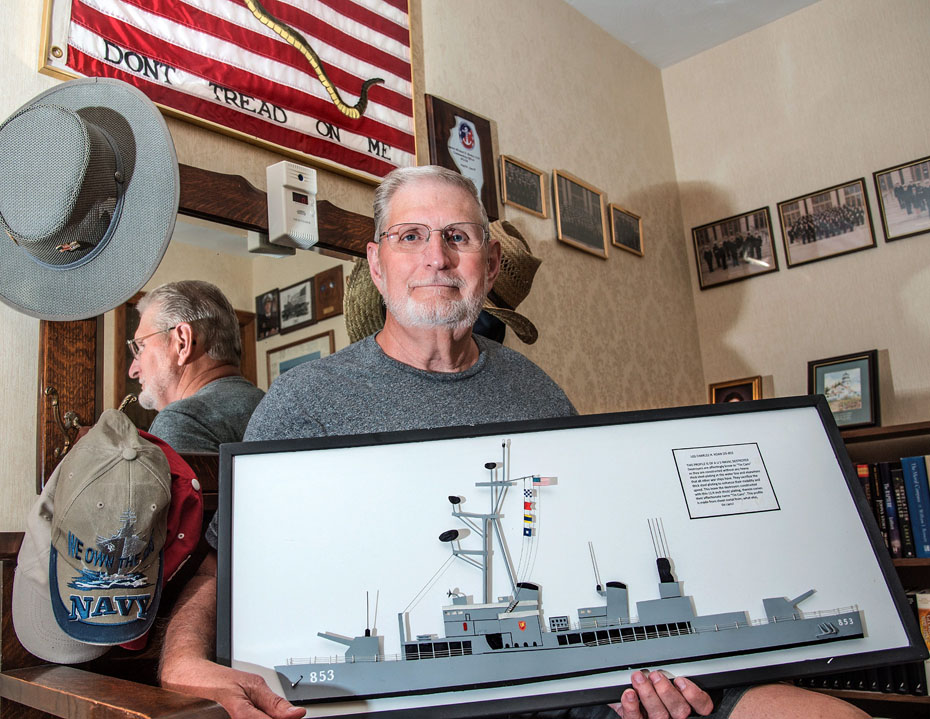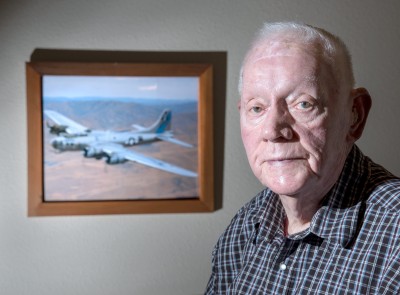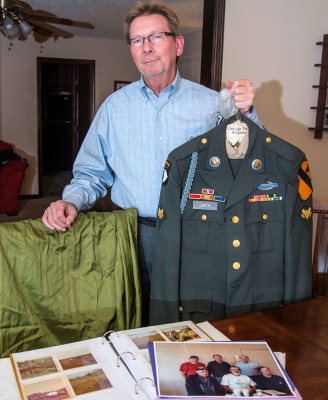Mike Barker
By Paul Wood

Photo By Heather Coit/The News-Gazette
SAVOY — From blowing up enemy barges in Vietnam to commanding sailors who fought Saddam Hussein’s forces, Capt. Mike Barker did more than his share in the service of the United States.
The veteran, 73, spent 311/2 years in the Navy, including two deployments to Vietnam.
Spending that much time on naval bases or ships meant Barker missed most Fourth of July celebrations here. Independence Day was often spent in the Pacific; he recalls huge parties in Japan.
Barker’s Vietnam service was part of a career that included serving on a destroyer for four years, commanding amphibious ships in the Persian Gulf, serving in the Pentagon and coming to the University of Illinois to head the Naval ROTC program.
Growing up in Oklahoma, Barker thought he’d blown out his knees playing basketball for the University of Tulsa, but still passed his draft physical.
So he enlisted in the Navy on March 10, 1966, soon went to Officer Candidate School and was an ensign in the Vietnam era.
In June 1970, he was sent to the seas off Vietnam on the USS Rogers. It traveled from San Diego to Guam to the Philippines before it was on the gun line.
“The gun line concentrated fire when given a time and location,” he said.
The ship’s 5-inch guns weren’t powerful enough to penetrate the enemy’s concrete bunkers; larger ships took care of them by exploiting a weakness, firing so that the shells came in underneath them.
But the 5-inchers were effective against North Vietnamese gunboats.
“They were a worthy opponent,” he says.
In several operations, his sailors faced off against concrete barges carrying ammunition.
“We had orders to follow; it wasn’t anything like I’d ever seen before,” he says. “We blew up those barges and the ammunition went off. I was below decks, working as an engineer, but the men topside said it was something to see.”
Sailors even found a couple of the barges that the current had floated 100 miles out to sea and destroyed them as navigation hazards.
Sailors tossed grenades at the barges, or shot at them.
In 1970, the Rogers had a collision with an Australian tug showing no lights.
“We wrapped our bow around it pretty good,” Barker says. “We had to cut out a section of the bow; as chief engineer, I was responsible.”
The ship was vulnerable while the work was being done. At night, sappers — North Vietnamese saboteurs — set out to approach it while hanging on logs, with packs of ammunition on their backs.
“It was a suicide mission,” Barker says. “I am a pretty good shot and hit them, and blew their charges up. The crew really ate that up.”
After Vietnam, the Cold War continued. Soviet ships “snooped” on the USS Apache when it was on a sea search for a package dropped by a SR-71 spy plane.
“We could outrun the Soviet snoopers and move out of the area, but we were often cutting across each other’s bows,” he says.
Later, Barker took command of an amphibious group before Desert Storm began in 1991. The 13-ship force was the largest amphibious task force from the West Coast in 25 years.
At the time, the Iraqi occupation of Kuwait was entering its fifth month.
The West Coast task force was ordered to land forces and equipment ashore in support of combat personnel already in the Kuwaiti theater of operations.
Barker took command from his flagship, the USS New Orleans.
When the USS Tripoli struck a mine and suffered severe damage, the New Orleans assumed duties as the mine-countermeasures ship for the entire Persian Gulf.
As the war came to a close, many commands began returning to the United States. Barker’s squadron was among the last to remain in the Persian Gulf.
He served in the Pentagon, then to San Diego, and moved to the Champaign area when he took command of the Naval ROTC here.
Barker is married to Linda; they have two children and four grandchildren.
Do you know a veteran who could share a story about military service? Contact staff writer Paul Wood at pwood@news-gazette.com.
Read more stories from local veterans:
 Harold Huffman
MAHOMET — Surviving the crash of his B-17 bomber, Tech Sgt. Harold Huffman spent the rest of World War II in Sweden, hel …
Harold Huffman
MAHOMET — Surviving the crash of his B-17 bomber, Tech Sgt. Harold Huffman spent the rest of World War II in Sweden, hel …
 Lee Smith
CHAMPAIGN — This draftee won a Bronze Star in Vietnam. Champaign Certified Financial Planner Lee Smith, 64, was a grunt …
Lee Smith
CHAMPAIGN — This draftee won a Bronze Star in Vietnam. Champaign Certified Financial Planner Lee Smith, 64, was a grunt …
 Matt Kreeb
GILMAN — Sgt. Matt Kreeb was eager to serve his country. The Iroquois West grad served in the prestigious and demanding …
Matt Kreeb
GILMAN — Sgt. Matt Kreeb was eager to serve his country. The Iroquois West grad served in the prestigious and demanding …